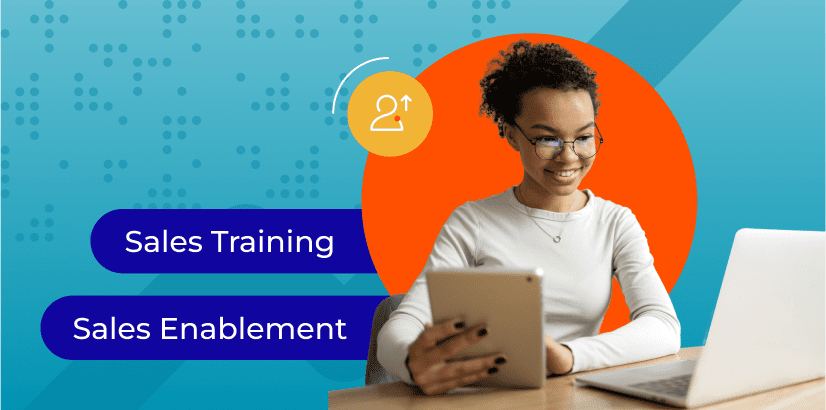The Ultimate Guide to Building a Sales Enablement Strategy
![]() Helen Waite
on
January 10, 2024
Helen Waite
on
January 10, 2024
When sales enablement is done well, we know it gets results. Research shows that orgs with sales enablement achieve a 49% win rate on forecasted deals, compared to 42.5% for those without.
Win rates for orgs
But there’s still a disconnect.
According to CSO Insights, only 27.5% of stakeholders feel that sales enablement initiatives meet or exceed their expectations
A well-designed sales enablement strategy can provide the necessary tools, resources, and support to empower sales teams and drive revenue growth.
In this guide, we will explore:
- What sales enablement is
- Why it is important
- How to implement a sales enablement strategy
- Best practices to consider
- How to find the best sales enablement platform
What is sales enablement?
Sales enablement is the training, tools, and resources provided to sales reps to help them successfully close more deals. The goal of sales enablement is to equip salespeople to be indispensable consultants to their buyers, build long-term customer loyalty, and drive profits for the organization as a whole.
With an effective sales enablement program, reps are better equipped to provide their customers with valuable information and offer insight that guides buyers into optimal purchasing decisions. Salespeople, therefore, become trustworthy resources that buyers rely on for the long haul.
Why is a sales enablement strategy important?
With a clearly defined sales enablement strategy, sales enablement practitioners can continually drive revenue and achieve key business objectives like quota attainment.
A sales enablement strategy encompasses a range of tactics and initiatives aimed at empowering sales teams with the necessary tools, knowledge, and support to drive success.
The importance of a sales enablement strategy lies in its ability to address common obstacles faced by sales teams, streamline processes, and maximize the potential of every salesperson. By aligning marketing and sales efforts, optimizing training and development, and providing the right resources, a sales enablement strategy can have a profound impact on an organization’s bottom line. Here are just a few hard-to-ignore benefits of sales enablement:
#1 Onboard new salespeople faster
Sales enablement is critical for organizations to onboard new salespeople faster, ensuring they are equipped with the knowledge and skills to contribute quickly. In fact, our 2022-2023 Sales Enablement Outlook Report found that almost a quarter (23%) of C-level sales executives said onboarding was a top priority in 2023. By reducing ramp-up time, organizations can accelerate the time it takes for new hires to become productive members of the sales team, resulting in increased revenue generation.
#2 Enable salespeople to spend more time selling
Almost 65 percent of a salesperson’s time is spent on tasks that don’t generate profits, such as administrative work or data entry. Effective sales enablement programs help an organization identify processes that waste time so reps can be more efficient and profitable. Some sales enablement technology can also automate CRM data entry and other repetitive, manual processes so reps can spend more time selling.
#3 Help retain sales talent and boost revenue
Sales enablement ensures that salespeople have the support and resources they need to succeed. This not only increases job satisfaction and reduces turnover but also helps drive revenue growth by equipping sales teams with the necessary skills and knowledge to close deals. Enablement driving more revenue means more sellers are meeting or exceeding their quota. In addition, an enablement strategy that encompasses sales coaching ensures a more positive relationship between sales reps and their managers, also reducing churn and turnover.
#4 Effectively meet next year’s increased quotas
An organization’s plans to increase sales quotas can be a stress point for sales managers. While most of the top salespeople will be ready for the higher requirements, many of the C- and B-players will need to be coached up to prepare. Sales enablement mitigates this challenge by using bespoke training processes that shorten sales cycles and boost sales rep performance.
#5 Maintain a long-term strategy in seasons of high growth
As the business grows, organizations experience new customer expectations, unexpected employee challenges, and other growing pains. When company leadership gets caught up in these urgencies, they’re usually focused on the here and now rather than long-term strategies and future growth. This approach, albeit understandable, leads to unpreparedness over time.
Effective sales enablement programs help organizations conduct effective sales training and coaching to prepare reps for future growth even while other priorities dominate leadership’s attention.
Naturally, all of these benefits work to achieve the most important goal of any sales team: driving revenue. Sales enablement empowers reps to become more knowledgeable, maximally efficient, and capable of building profitable client loyalty that the competition can’t match.
How to implement a sales enablement strategy
Because every organization is different, there isn’t just “one right way” to implement a sales enablement program. There are, however, a few important pillars to keep in mind. Here are a few non-negotiables:
The first step to creating your sales enablement process is to establish your sales enablement manager. This person will be responsible for unifying marketing and sales and overseeing the entire process, so the person should be a great fit for both areas and have the buy-in of executive leadership.
For a sales enablement process to succeed, your organization will need an environment of alignment and unification. No more silos, anywhere! The unification process might be one of the first tasks of the sales enablement manager.
First, the executive team must be aligned and supportive of the organization’s sales enablement mission. Next, all employees in the organization, especially marketing and sales, need to understand the role of enablement and how marketing and sales interact and support the enablement function. Some common frameworks, like RACI, can be really helpful here when outlining all of the priorities for enablement and how other teams will work together to achieve shared goals.
In collaboration with marketing, start developing your onboarding materials and an everboarding strategy. If there is onboarding already in place, interview newly onboarded reps on their experience and measure key indicators like time to first deal and time to fully ramped quota. Use this information to determine changes in your onboarding approach. Use best practices in enablement like making training engaging, using many modalities of instructor-led, bite-sized microlearning, and knowledge tests.
You’ll also want a sales coaching system in place for ongoing encouragement and development. This will require a strong partnership and buy-in from your sales management to implement. Check out our resources on implementing a coaching culture.
Next, equip reps with content and vital field resources that will help them effectively sell and provide value. These can include white papers, data sheets, sell sheets, product videos, and playbooks that outline effective next steps and milestones. An effective sales content management system can ensure your content is available to reps anytime, the content is up to date, and can be tracked as they share collateral with prospects.
Also, offer in-depth information about buyers and buyer personas so your team can effectively maintain long-lasting buyer relationships. This can include persona deep-dives, common pain points, industry knowledge, and use cases that solve persona challenges.
Now that you have the key pillars of your sales enablement strategy in place, ensure you have open channels for feedback from all stakeholders. This includes your reps, like issuing surveys and conducting interviews to gain insight into their experience going through onboarding and ongoing enablement. Meet regularly with your sales leaders and sales managers to stay apprised of challenges their teams are facing and how enablement can be nimble and release targeted programs to resolve these. Finally, attend weekly pipeline and forecasting meetings with your CRO or CSO to know how deals and teams are progressing, where gaps are related to deal stages or competitive hardships, and how enablement can be leveraged to accelerate and close more deals.
Sales enablement best practices
With a solid sales enablement foundation in place, you can now build on it. These best practices will help boost the effectiveness of any sales enablement program.
Just as the sales team should be aligned with the marketing department, sales enablement should be aligned with sales operations. The role of sales ops is to ensure that the sales organization is functioning efficiently. A sales enablement program should therefore be built and maintained with sales-ops in mind.
Sales enablement should glean from the data that sales ops uncovers. For example, sales ops might reveal certain stages in the sales cycle that are falling flat. When problems are flagged by sales-ops, sales enablement can roll up its sleeves and determine the best fixes.
Staggeringly, up to 80 percent of content created by marketing goes unused by sales teams. Much of the reason for this low usage stems from a lack of marketing-sales alignment. But another simpler reason is that reps either can’t find the content they need or they don’t even know a certain piece exists.
Lengthy course work is difficult to remember and frustrating to reps. Microlearning removes the frustration by presenting content in short, easy-to-consume training modules. Short and engaging learning sessions improve memory retention, reduce learner fatigue, and make training enjoyable. Microlearning modules are also easy to update and less expensive than traditional training formats.
Your sellers are just one piece of the revenue puzzle. Ensure your enablement extends beyond sales, to other revenue-generating roles such as:
- Customer success
- Presales
- Sales engineers
- Business development representatives
- Marketing
This is becoming more popular in terms of revenue enablement. Some enablement departments even break their team members up to focus on enabling certain roles. If you are able to grow or restructure your enablement team, consider focusing resources on the additional revenue-generating roles outside of sales.
How to find a sales enablement platform and what to look for
When researching sales enablement platforms, begin with a list of must-have features based on your needs and nice-to-have features. Consider some of these table stakes capabilities when creating this list.
Trainers should be able to create engaging micro-learning modules and update them as needed. The modules should be mobile-friendly so reps can access them anytime and from anywhere. Automated training paths are a must for ensuring each team member is progressing in his or her specific role. Also, look for gamification capabilities that provide scoring, badges, and leaderboards for healthy team competition.
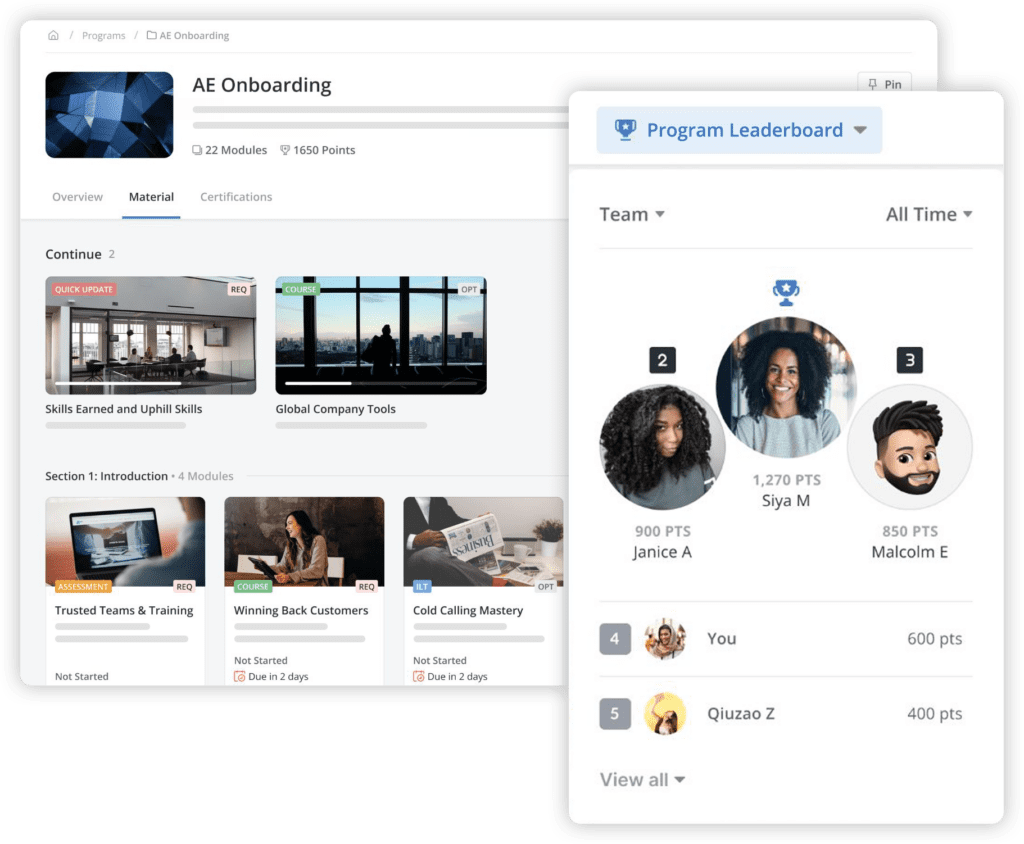
Look for a platform that provides sales certifications to help reps and managers track progress. If you can accurately gauge whether or not reps have acquired the intended knowledge and identify any gaps, you’ll be confident every time a rep comes face-to-face with a client.
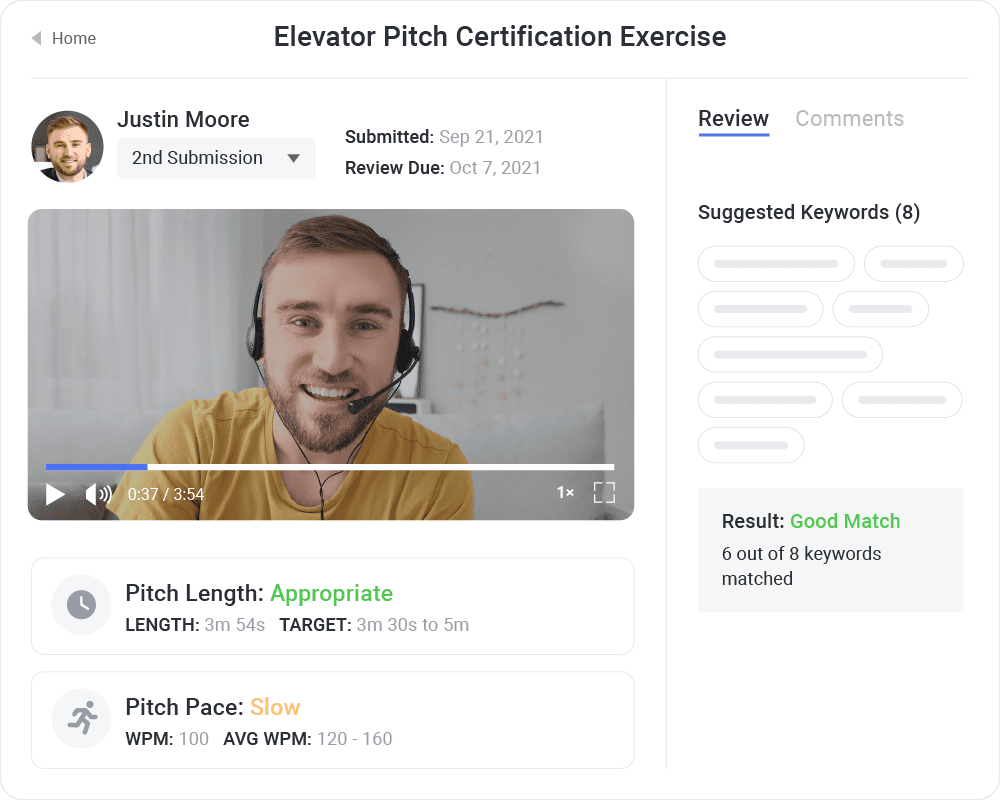
Streamlining your sales and training content in a singular enablement platform is key. You want to ensure you can easily store and manage sales collateral, making it filterable and easy for sales reps to find in the moment. A huge plus in a sales content management platform is the ability for reps to share content with prospects and customers and track their engagement. We also suggest a content management provider that also has digital sales rooms for tailored buyer enablement.
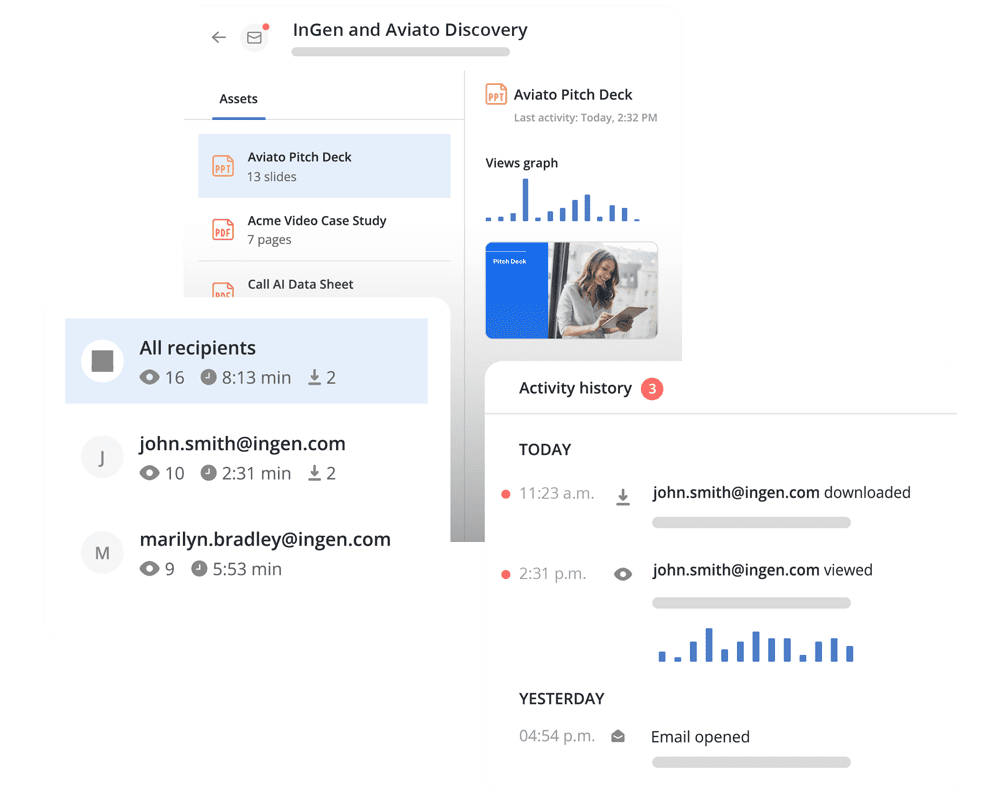
You’ll want to find a sales enablement platform that enables you to incorporate a structured coaching program. Coaching paths should be guided by competency maps, and your coaches should be able to assign new training and micro-learning modules based on the results of the coaching. In addition, knowledge retention for a range of topics including products, services, and industry trends is critical for sales representatives to have educated, direct conversations with customers and prospects. In addition, the ability to deliver role-plays (including video-based and screenshare) and get immediate AI-powered feedback on role-plays are critical for skill development.
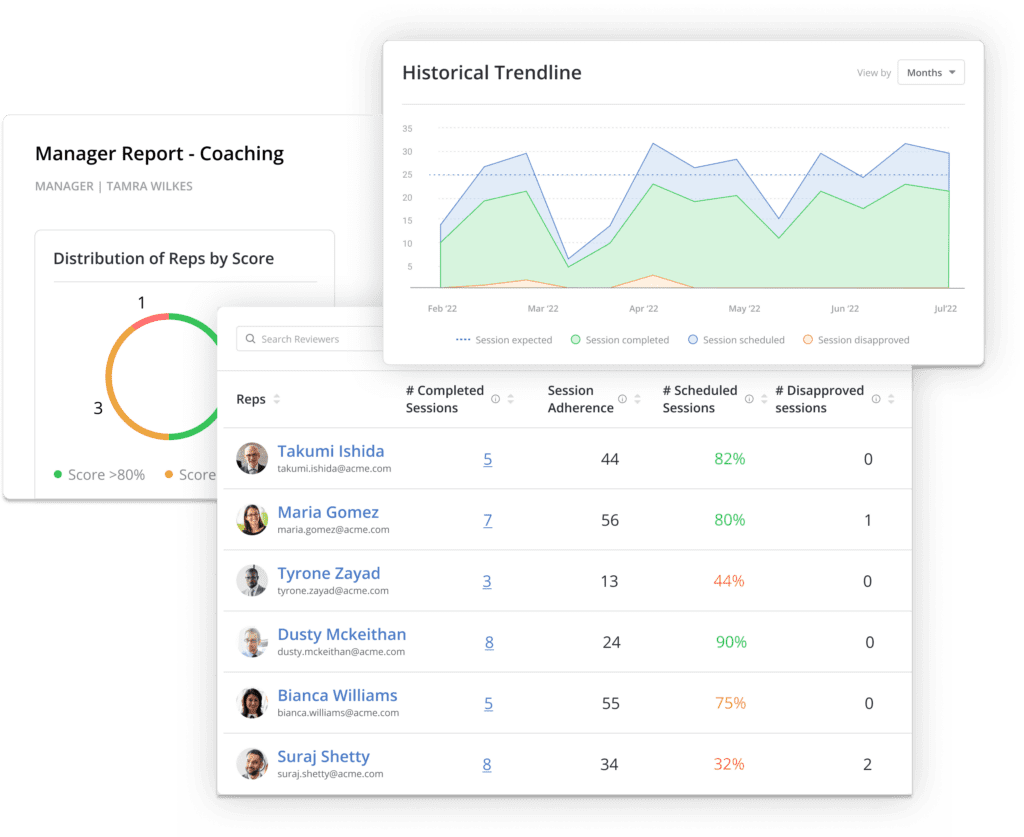
Sales Kickoff and events are intended to make a lasting impact on sales reps’ motivation and readiness. You’ll ensure time and money are well spent by leveraging the technology that a great sales enablement tool can offer. Find a platform that can collect, measure, and analyze feedback during every step of your SKO or event to determine what worked, what could be improved, and whether or not your desired objectives have been met. Even more, your platform should allow reps instant access to videos and presentations shown during the event, which will encourage teams to continue their engagement.
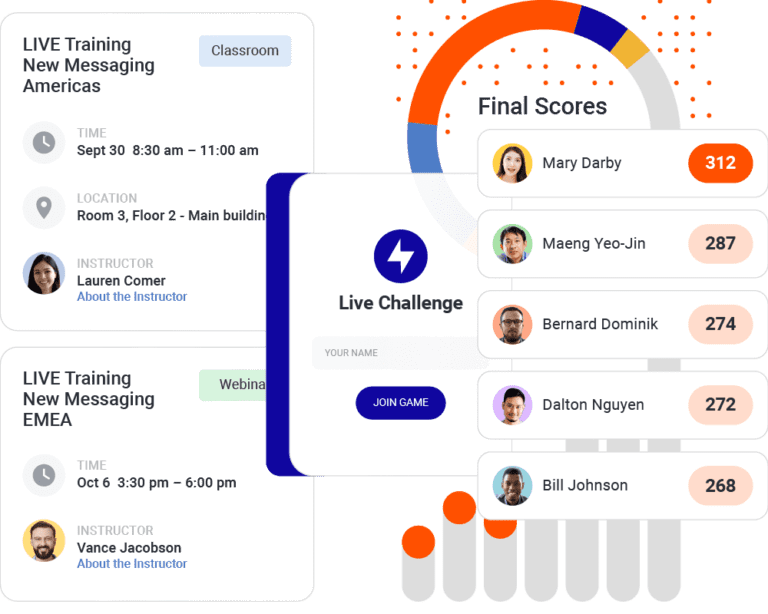
Look for a platform that provides the ability to integrate with CRMs, business intelligence tools, content management systems, and communication tools. This will provide a seamless and efficient sales enablement ecosystem.

There are table-stakes analytics and reporting that should be available like engagement, adoption, and performance on enablement programs. Also, seek platforms that can report on the impact enablement is having on business outcomes like quota attainment, win rates, and increase revenue. Bonus points for being able to import data into Business Intelligence tools for even deeper analyses.
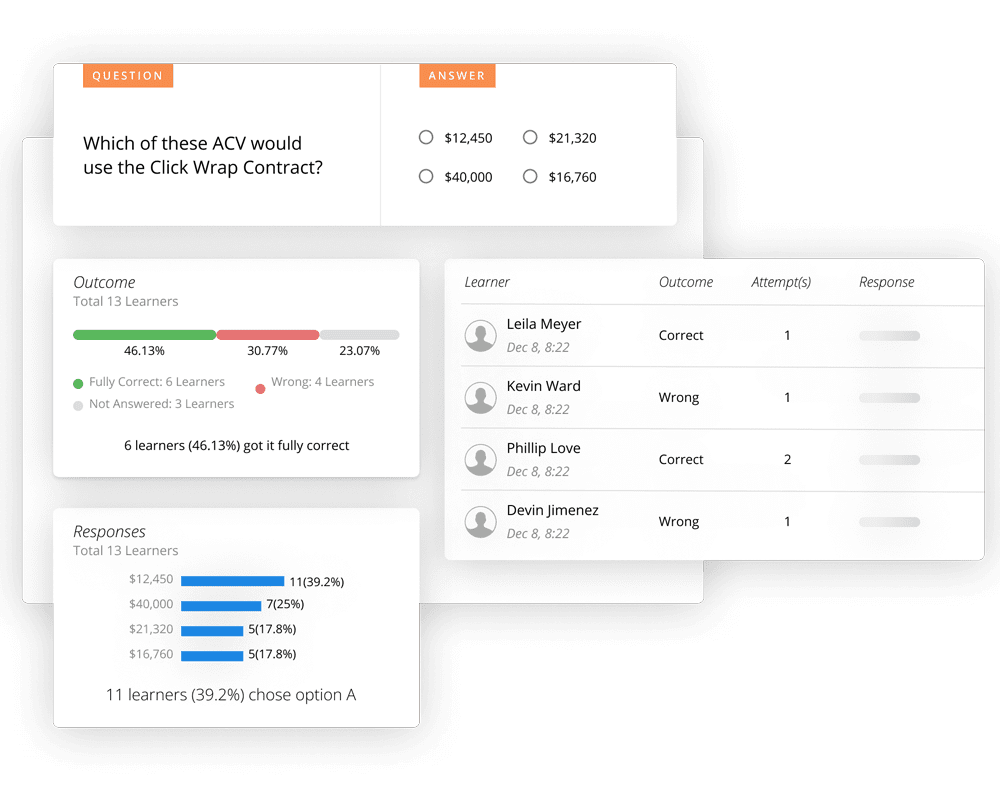
Getting started with your sales enablement strategy
Now that you’ve learned the importance of enablement, how to structure a strategy, and how to implement that strategy it’s time to start driving revenue for your organization.
Sales Enablement in Mindtickle
Request a demo to learn more about how the Mindtickle data-driven sales enablement platform can help your sales teams close more deals.
Request a DemoThis post was originally published in January 2020, updated in June 2023, and again in January 2024.

